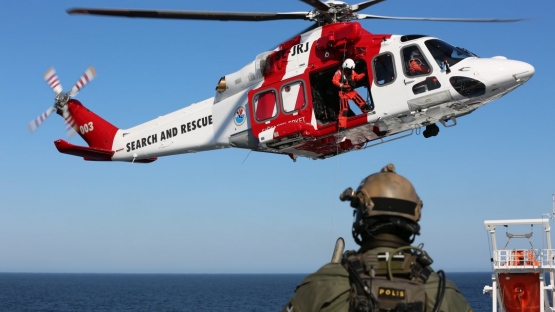Like an action movie set, ships, helicopters and uniformed people set the scene off the coast of Sweden this week as national authorities conducted an exercise on security while transporting spent nuclear fuel. The exercise was part of a joint project with the IAEA to test and evaluate a new IAEA guide on planning, conducting and evaluating transport security exercises. The test subject and model was the security framework of Sweden’s national nuclear transport system, which regularly ships used fuel from power plants along the coast to the country’s interim storage facility for spent nuclear fuel.
“In addition to supporting the IAEA in the development of the exercise guide, the field exercise provided an excellent opportunity for training in a realistic situation not only for the regulatory authority, the coast guard and the police counter terrorist unit, but also for the company responsible for transport operations,” said Tommy Nielsen, the exercise director from the Swedish Radiation Safety Authority. “This exercise was also a chance for Sweden to further improve its national transport security system.”
The IAEA reviewed Sweden’s nuclear transport security system in 2011 and provided advice on implementing international standards and IAEA guidance on the physical protection of nuclear and other radioactive material and associated facilities, including good practices, recommendations for improvement and follow-up activities. Sweden subsequently became closely involved with the IAEA in the development of the exercise guide.
A scenario at sea
The field exercise was a full-scale, comprehensive scenario involving national authorities overseeing the M/S Sigrid, a purpose-built vessel, carrying a shipment of fake spent nuclear fuel from the Forsmark nuclear power plant. The scenario unfolded as the vessel headed south to an interim storage facility and was intercepted by an unidentified armed group, which took control of the vessel and forced the crew to comply with their instructions.
Authorities jumped into action.
Relying on their prepared plans and extensive training, key personnel from the Swedish Radiation Safety Authority, national police, the coast guard and the Swedish Nuclear Fuel and Waste Management Company worked together to regain control of the vessel. Their plans were carefully designed around national regulations and training, as well as IAEA nuclear transport security guidelines and preparatory exercises. The strategy also relied on results from a tabletop, discussion-based exercise with around 100 participants and observers held earlier in February as part of the exercise preparations.
With close coordination and quick thinking, authorities successfully overcame the attacking group and regained control of the vessel.
Events such as this exercise help raise security standards across States and contribute towards a consistent, safe and secure approach to the transport of nuclear material.



